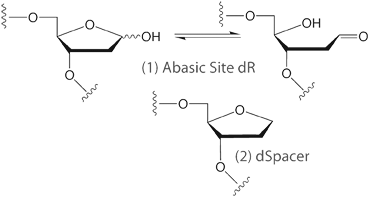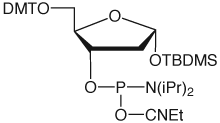This article is an edited and updated version of the original published in Glen Report 14.1 (2001). Our conclusion at that time was that the Abasic Phosphoramidite that we introduced then offered the best combination of price and functionality for the generation of abasic sites. However, steric hindrance always ensured that low coupling efficiency was observed with this monomer and the subsequent chemistry to form the abasic site was challenging. Consequently, we decided to review the situation.


Hydrolysis of nucleoside residues in DNA occurs naturally to generate abasic sites. Most commonly, dA sites are hydrolyzed causing depurination and leading to abasic residues. Although this process is slow under physiological conditions, the reaction is faster at lower pH and especially if the bases are already oxidatively damaged. Damaged bases are also removed enzymatically by the action of DNA N-glycosylases (Base Excision Repair). The abasic residue (dR) exists predominantly in the cyclic form and the structure is shown (1) in Figure 1. The poor stability, especially in basic medium, is caused by the tendency to beta-elimination, leading to chain scission with formation of the 3’-phosphate and 5’-OH.
Because of the instability of the abasic residue, it has not been simple to prepare this variant by chemical synthesis. However, some excellent results have been generated using the stable dSpacer tetrahydrofuran analogue.1-4 This variant (2) is missing the 1’-OH of dR and is stable during oligo synthesis, purification and storage.
It is possible to produce the genuine abasic site enzymatically using N-uracil glycosylase to remove uracil base from a 2’-deoxyuridine residue. A potentially very useful chemical method was described by Rayner.5 In this method, the abasic site is protected with a photolabile 2-nitrobenzyl group during oligonucleotide synthesis and purification. The 2-nitrobenzyl group is then eliminated by photolysis to produce the abasic site. A similar strategy has been used that incorporates a 2-nitrophenylethyl6 photolabile group. As always, there is the concern of thymine dimer formation during photolysis.
Other methods7,8 have been used to generate abasic sites but, in all cases to date, the synthesis of the monomer is fairly challenging and, in our opinion, the subsequent chemistry to generate the abasic site is hardly routine.
The chemical method described by Francis Johnson’s group9 allows the generation of abasic sites in double and single stranded oligonucleotides using very mild specific conditions and with very low probability of side reactions. However, the product exhibits low coupling efficiency due to steric hindrance of the phosphoramidite by the surrounding silyl protecting groups. The post-synthesis chemistry is also fairly challenging.
Christian Leumann’s recent photochemical route6 prompted us to reexamine a much earlier silyl protected monomer.10 This product has the advantage of simplicity and the phosphoramidite monomer, Abasic II Phosphoramidite (3) can be prepared at reasonable cost.
The reactivity of Abasic II Phosphoramidite is similar to regular DNA phosphoramidites and a 6 minute coupling reaction gives excellent coupling efficiency. The single silyl protecting group is acid labile but we have shown that it survives 20 synthesis cycles using TCA as the deblocking reagent. The silyl group is removed simply post-synthesis using aqueous acetic acid. The solution is then neutralized with buffer and the oligonucleotide containing abasic sites is desalted on a Glen Gel-Pak™ column in the storage buffer of choice.
With the availability of oligonucleotides containing abasic sites, detailed stability information is now available.9 The abasic site is stable almost indefinitely in 0.2M triethylammonium acetate buffer (pH6) at 5°C or less. However, the site is less stable at room temperature (half-life of around 30days) and quite unstable at 55° (half-life of about 7 hours). Interestingly, the abasic site is largely degraded during evaporation to dryness.
Melting behavior of oligonucleotides containing the abasic site was examined9 and it was found to behave like a complete mismatch opposite the 4 natural bases, with characteristics almost identical to those of dSpacer, which has been used extensively as a model abasic site. Other physical characteristics of oligonucleotides containing abasic sites have been examined, as well as their implication in DNA damage and repair.11,12 Recently, Leumann has examined the stability of DNA abasic sites with equivalent RNA abasic sites.6